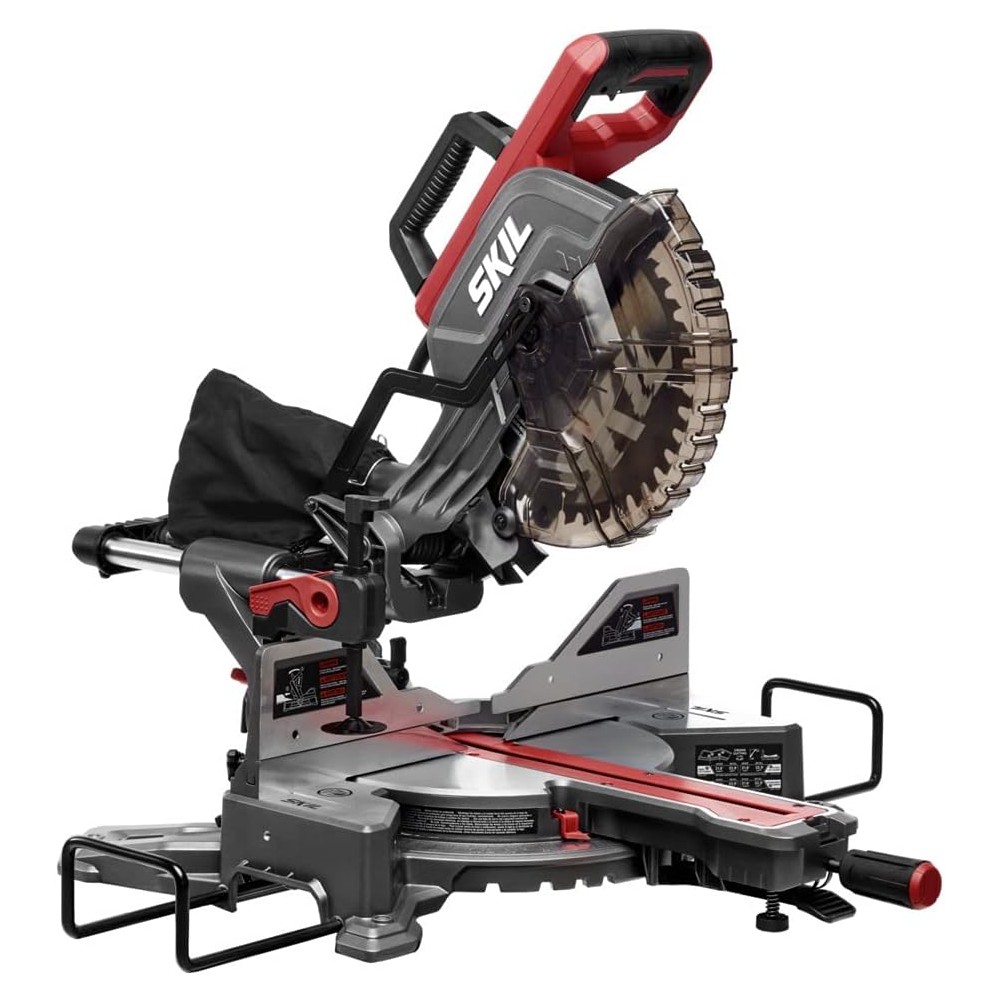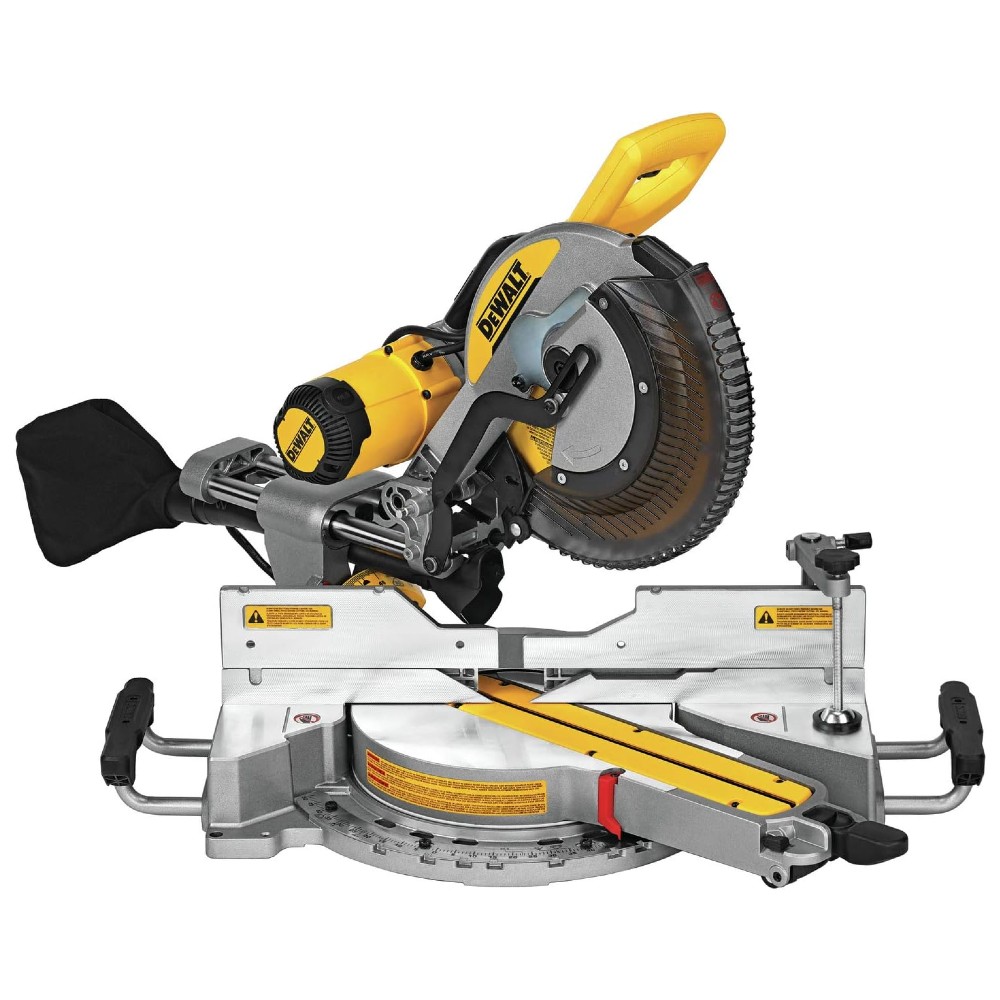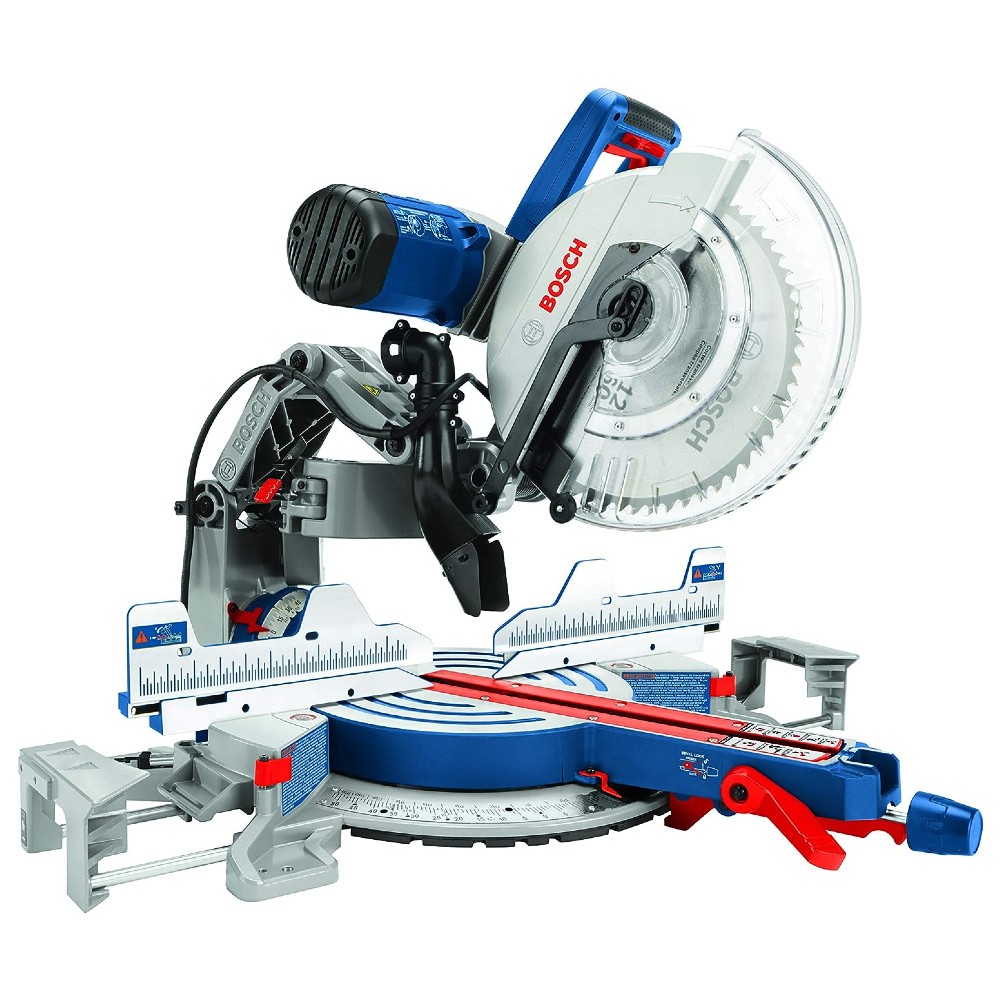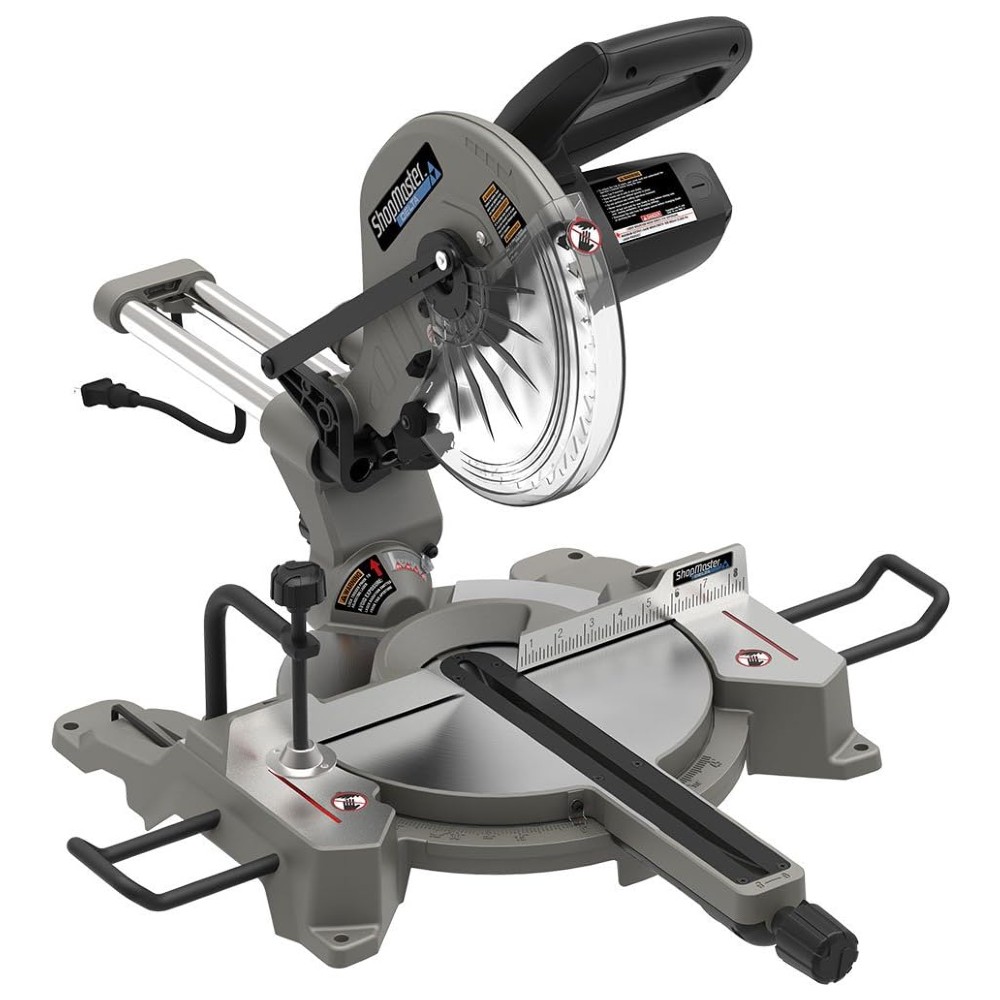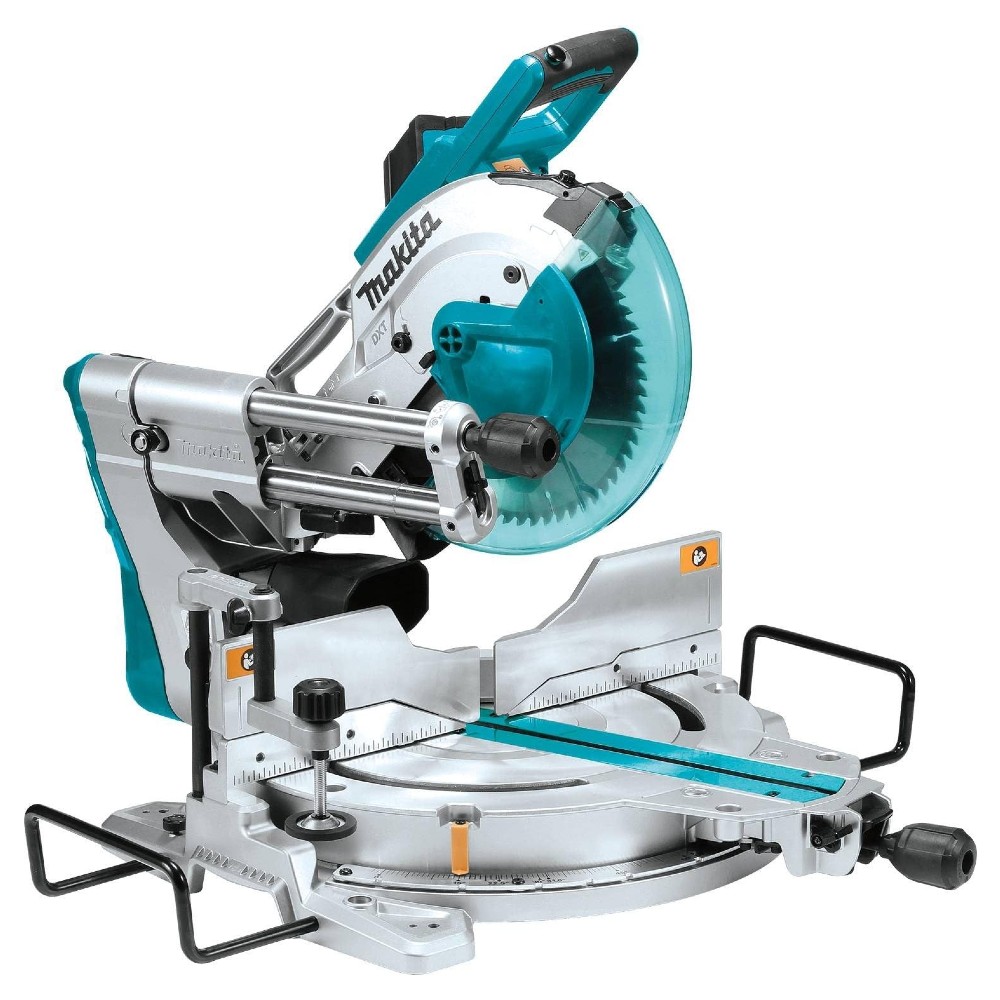The Best Sliding Miter Saws for More Accurate Cuts
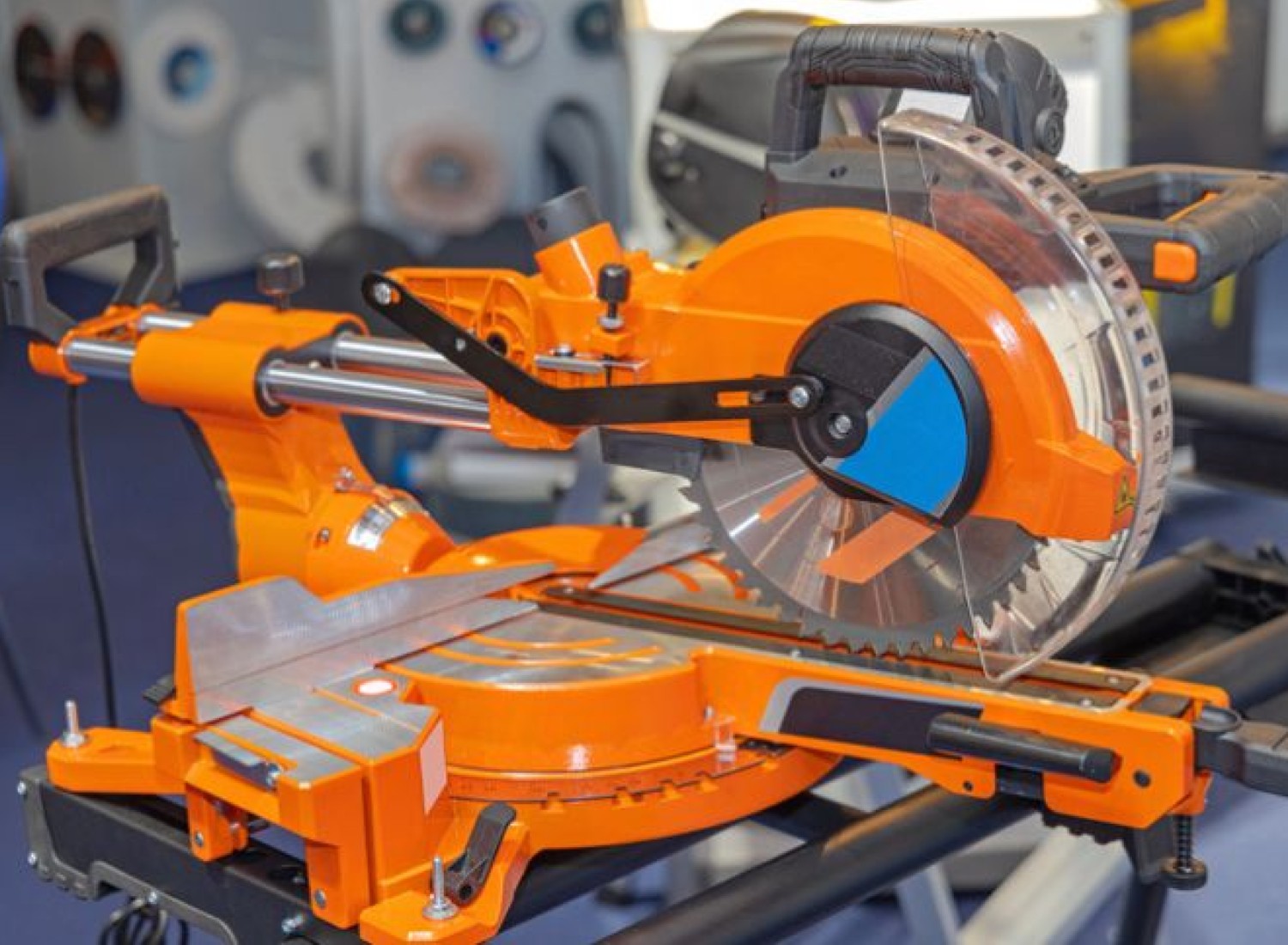
- Best Overall: Skil Sliding Miter Saw Shop Now ➔
- Heavy Duty Option: DEWALT Sliding Miter Saw Shop Now ➔
- Smoothest Design: BOSCH Sliding Miter Saw Shop Now ➔
- Affordable Pick: Delta Sliding Miter Saw Shop Now ➔
- Most Innovative: Makita Sliding Miter Saw Shop Now ➔
Comparing the Top Sliding Miter Saws of 2024
Best Overall
If you’re looking for a smooth and compact sliding miter saw, then I think this product from Skil may be your match. It features a powerful 15-AMP motor that delivers 4,800 RPM for superior speed and accuracy. With dual bevel capability and boasting 11 positive stop positions at the most commonly used angles, you can also make very precise cuts with ease.
The LED shadow line is a handy feature that helps you align your cuts better than lasers, making this saw suitable for any project. The saw’s ergonomic design makes it easy to use for long hours, and the dust bag collects the dust from your projects, making cleaning simple. It also has a large cutting capacity, meaning you’ll be able to cut thick and wide materials with ease. Together, all of these characteristics place this impressive sliding miter saw at the top of our list!
Pros
- Sturdy and well-constructed build
- Clear miter and bevel measurements
- Makes very precise cuts
- User-friendly and easy to set up
Cons
- Cannot be hooked up to shop vacs
Heavy Duty Option
With a 12-inch blade with 10 positive stops on a stainless steel plate, the DEWALT Sliding Miter Saw can easily make precise cuts at different angles. You can also adjust the miter system and the cam-lock handle to fine-tune your miter angles. The cam-lock miter handle provides quick and accurate miter angles with a detent override, and it comes with a precise miter system that has a machined base fence support. Plus, its tall, sliding fences can vertically support 6 ¾ inches of material.
Even better, this sliding miter saw can handle a variety of materials and sizes. You can bevel the blade from zero to 48 degrees on both sides, and cut up to 2 inches by 14 inches of lumber at 90 degrees, or 2 inches by 10 inches at 45 degrees. The saw also has a sturdy and smooth design, thanks to the dual horizontal rails, a clamping mechanism, and linear ball bearings. Meanwhile, an efficient dust collection system captures over 75% of dust, making it a great choice for any workspace.
Pros
- Large, easy-to-read bevel scale
- Features a dust catcher bag
- Powerful 15-amp motor
- Great for making straight cuts
Cons
- A very heavy machine
Smoothest Design
The BOSCH Sliding Miter Saw is a top-of-the-line saw that is perfect for any type of cutting job. The patented axial glide system allows for wider cross-cuts and better alignment with a fraction of the space a typical saw needs, meaning you’ll save 12 inches of valuable workspace. The saw also features adjustable miter scales with roof pitch angles and stainless steel miter scales as well as a large, easy-to-read uniform bevel.
Beyond those useful features, the saw has a one-touch lock-and-unlock system when sliding the fence for added support. It even comes with all the necessary extras that you’ll need to get started, making it an all-in-one solution for your cutting needs. This includes the saw, one wrench, one vertical work clamp, one dust bag, a vacuum adapter elbow, and a 12-inch, 60-tooth carbide-tipped blade.
Pros
- Axial-glide system reduces dust buildup
- Smooth gliding action
- Impressively accurate results
- Making adjustments is easy
Cons
- Lacks crown stops
Affordable Pick
The Delta Sliding Miter Saw is a lightweight unit with table extensions that can easily support longer pieces of wood. Thanks to the spindle lock, users can securely hold the spindle while they loosen and remove the blade nut. You can also make different types of cuts, such as bevels from zero up to 45 degrees.
This miter saw is equipped with an improved laser as well, making it easy to align the blade with the workpiece for much more accurate cuts. Perhaps my favorite thing about it, though, is that you can turn the laser on and off with a switch, which isn’t common in other sliding miter saws. All in all, I’d say that this is a great choice for any DIY enthusiast or professional carpenter who wants to make smooth, accurate cuts on a budget.
Pros
- Easy and quick angle adjustment
- Lightweight for easy transport
- Strong motor with good torque
- Great quality for an affordable price
Cons
- Too loud for some
- Tends to make a mess
Most Innovative
With a 10-inch saw and equipped with a laser, the Makita Sliding Miter Saw is a superb choice for making precise nested cuts. First off, the saw uses a linear ball-bearing system to help you make more accurate cuts. It also comes with an innovative direct drive gearbox and guard system to increase the vertical cutting capacity to 5 ¼ inches. Meanwhile, the unique two-steel rail sliding system design permits single slide-glide operation and reduces the saw’s overall footprint, allowing you to operate it flush against a wall. And the best part? This sliding meter saw weighs in at only 59 pounds, so you can easily carry it around wherever you need it.
Pros
- Robust, powerful motor
- Superior dust collection
- Upfront bevel knob locks tightly
- Excellent cutting capacity
Cons
- Doesn’t cut straight enough for some users
Buying Guide: Sliding Miter Saw
Sliding miter saws are versatile and powerful tools that can handle various woodworking and DIY projects. Whether you need to cut trim, molding, or framing lumber, they can easily and effectively make smooth, precise cuts. With so many models with different features and capabilities, however, it’s safe to say not all of these saws are created equal. To find the best one for your needs, here are some key features I suggest paying attention to when shopping for a sliding miter saw.
Quality
The saw motor’s power and RPM indicate the type of projects the saw can handle, as well as the level of precision it can deliver. Before you buy a saw, check its motor’s specifications and make sure it can handle whatever you intend to cut. Also, examine the included blades to ensure they’re equipped with sharp teeth that can cut a wide range of materials.
Maximum Cutting Width
When you buy a miter saw, you need to think about how wide your cuts will be. Before purchasing, measure your stock pieces to ensure the saw you select will accommodate your needs. Some saws have sliding arms that let you make wider cuts, so if you plan on making longer cuts, choose one that’s equipped with these arms.
Maximum Cutting Depth
A sliding miter saw’s maximum cutting depth refers to how far into a piece of material it can cut. Different saws have different maximum cutting depths, so you’ll want to compare them before you buy one. If you’re working on projects that require deep cuts, be sure to look for a saw that can handle them.
Type of Miter Saw
When it comes to choosing a miter saw, you’ll notice there are three main types: single bevel, dual bevel, and sliding. Single bevel saws can only tilt in one direction, while dual bevel models can tilt to both the right and the left. In comparison, a sliding miter saw offers much greater versatility because it increases the distance between the blade and the fence when making long, continuous cuts.
Laser Guide or LED Cut Indicator
A laser guide or LED cut indicator can make it a lot easier for you to align your blade with the workpiece before making cuts. While not essential, I recommend considering them because they offer more accuracy when lining up cuts while making it easier to work with multiple pieces at once.
Adjustability
Depending on the material and the task, you may want to change the speed of your sliding miter saw’s blade. Most let you adjust the saw’s cutting speed to customize how fast or how slow the blade spins as needed. This is useful for ensuring precise cuts as well as extending the blade’s lifespan.
Dust Collection System
One of the benefits of a good dust collection system is that it keeps your workspace tidy and clear of sawdust or wood chips. When you are looking for a miter saw, make sure it has a reliable dust bag or port that can catch and remove any waste efficiently. This will make your work easier, safer, and less messy.
Ease of Changing Blades
Changing blades is an important part of your miter saw’s regular maintenance, and this shouldn’t be a hassle if you have a model that lets you easily access the blade. Look for features that make blade-changing quick and simple so you can get back to work faster.
Weight and Portability
If you plan on moving your miter saw around or taking it along with you to various job sites, then it’s important to buy one that’s both lightweight and compact. Some saws even have features like folding stands or retractable parts that make them more convenient to transport and store.
Price
When you’re shopping for tools, you might be tempted to go for the cheapest option, but that’s not always the best idea. Research some different models within your budget range and see what features they offer before making a final decision. Don’t assume that pricier saws are better in this case, because they might not be — always make sure you do your due diligence first.
Warranty
If you’re looking for a miter saw, don’t forget to check if a warranty comes with it. Some retailers offer great warranties that can save you money and hassle if something goes wrong with your saw. After all, you’ll want to have peace of mind that your saw is covered for a long time after you buy it.
Miter and Bevel Angles
When you cut a piece of wood, you need to consider two types of angles: miter and bevel. A miter angle is how much you deviate from a 90-degree cut, measured in degrees. A bevel angle is how much you tilt the blade away from a square cut, also measured in degrees. Make sure your chosen model has adequate coverage for both angle ranges. Some may go beyond standard angle ranges depending on their design, but if not, choosing one closer to 90 degrees may work better.
Noise Level
Sliding miter saws can be a great tool for your woodworking projects, but they can also be quite loud. If you want to avoid disturbing your neighbors or coworkers, always check the noise level specifications of each model before buying one. Some brands have made significant investments in reducing their saws’ sound output, which can make a big difference in the workplace.
Ergonomics
Ergonomics are key when using any tool. want to pay attention to how the handle fits your hand, size, trigger design, overall weight distribution, and more. All of these details can play an important role when it comes to your comfort level, so don’t take them lightly.
Sliding Miter Saw FAQs
What is a sliding miter saw?
A sliding miter saw is a large, heavy-duty power tool designed to make precise crosscuts and miter cuts in large pieces of wood, plastic, or metal. Unlike regular miter saws, sliding miter saws have a sliding arm that lets you move the blade back and forth. This gives you more cutting capacity and power. Plus, sliding miter saws can cut wider pieces of material due to their sliding arm.
What are the benefits of using a sliding miter saw?
A sliding miter saw's primary benefit is the ability to make accurate, wide-angled cuts without having to manually adjust the cutting arm or readjust the material being cut. This also makes the sliding miter saw more powerful and versatile, as it can handle thicker and larger materials with ease.
What kind of projects can be accomplished with a sliding miter saw?
Sliding miter saws are great tools for a variety of projects, including carpenter jobs, trimming moldings, frames, and other intricate woodworking tasks. They can be used to make precise cuts in larger boards or pieces of material that would otherwise be difficult to make with a standard miter saw.
Are sliding miter saws safe to use?
Sliding miter saws are powerful tools that can help you make precise cuts, but they also come with some risks. Thankfully, they come equipped with safety features like guards and fences, which protect users from sustaining injuries while using the saw. Another good way to stay safe is to keep the blade sharp and change it when it gets dull. And of course, you should always read the safety manual for your saw before you use it to operate it properly.
What types of blades should be used with a sliding miter saw?
The type of blades that you should use with your sliding miter saw depends on the material that you intend to cut with the saw. Generally speaking, there are either fine-toothed blades for clean cuts on softer woods or coarse-toothed blades for tougher materials, like hardwoods or metals. Make sure you also choose the right blade size for your machine, so you can get the best results and avoid any accidents while using the saw.
How do I properly adjust a sliding miter saw?
Adjusting your sliding miter saw requires that you loosen the screws that hold the blade in place. These screws are located near the base plate of the saw. After ensuring everything is secure and locked in place, test out your settings by cutting through some scrap wood before starting to use the saw for your project.
Article Contributors
The Woodsmith Review Team’s product reviews and in-depth guides are here to help you choose the best tools and gear to build great-looking projects confidently. Woodsmith is reader-supported: When you buy through links on our site, we may earn an affiliate commission. Large language models (like Artificial Intelligence) may have been used in the research and creation of the content.
Inquiries regarding specific articles or product testing should be sent to aimperiapt@gmail.com

